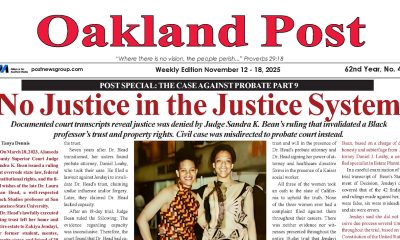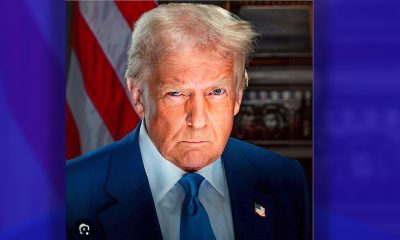Bay Area
Oakland Healthcare Unions Denounce CDC and California’s New Guidelines
While federal and California state guidelines now allow healthcare workers who test positive for COVID-19 to return to work without quarantining as long as they are asymptomatic until at least February 1, it’s unclear what this will mean for several Oakland healthcare facilities.

By Zack Haber
Two unions representing healthcare professionals have denounced recent moves by the Center for Disease Control (CDC) and The California Department of Public Health that have eased, or in some cases temporarily eliminated, quarantining guidelines for those who have tested positive for COVID-19 or been directly exposed to the virus.
“Part of why there’s this rise in transmission is that people aren’t quite well and they’re able to come out and mingle with the public,” said Zenei Triunfo-Cortez in an interview. Triunfo-Cortez has worked as a registered nurse for 42 years, and she’s the president of National Nurses United (NNU), a registered nurses’ union with over 175,000 members.
On December 22 of last year, as news that the CDC was considering shortening their COVID-19 quarantine duration guidelines from 10 days to five days was spreading, the NNU published an open letter to the director of the CDC, Dr. Rochelle Walensky, that urged her to maintain the 10-day quarantine period.
“Weakening COVID-19 guidance now, in the face of what could be the most devastating COVID-19 surge yet,” the letter reads, “will only result in further transmission, illness and death.”
On December 23, the CDC changed their guidelines for healthcare workers. To address staffing shortages, the new guidelines stated that medical facilities could have both vaccinated and unvaccinated healthcare workers who test positive for the virus return to their jobs immediately without quarantining in certain crisis situations as long as they were either asymptomatic or mildly symptomatic.
On December 27, the CDC changed their guidelines for the rest of the population, shortening the quarantining period from 10 to five days. The new guidelines stated that as long as a COVID-positive person has no symptoms or their symptoms are resolving and they don’t have a fever, they can end their quarantine on the sixth day.
“The change is motivated by science demonstrating that the majority of [COVID-19] transmission occurs early in the course of the illness,” reads a statement from the CDC about the reduced quarantine guideline, “generally in the 1-2 days prior to onset of symptoms and 2-3 days after.”
In their letter, the NNU pointed to the extremely contagious Omicron variant, and warned “Now is not the time to relax protections.” They mentioned pressure from businesses to maintain profits “without regard for science or the health of employees or the public” as the primary motivation for shortening the quarantine time. The letter included a link to a story about Delta Airlines CEO Ed Bastian asking the CDC to consider such a change.
Data from Alameda County, and California show that after the Omicron variant of COVID-19 began to become widespread in mid-December, local and statewide cases surged. By late December, average daily case rates were higher than they ever had been before.
Hospitalizations also rose sharply. Then cases and hospitalizations continued to rise through early January and have continued to rise. At the time of publication, information on recent COVID-19 deaths is unclear as the county and the state are updating that data.
“It’s stressful because some of our co-workers might be coming into work sick,” said Sonya Allen-Smith in an interview on January 7 about working under the new guidelines. She’s been an X-ray technologist at a Kaiser Permanente facility in Oakland for 13 years and is a member of the SEIU UHW union for healthcare workers.
“We think about if we’re going to take it home to our families,” she said. “My husband’s immune system is compromised. If I bring it home to him, he definitely will not make it.”
The Oakland Post obtained a flow chart Kaiser e-mailed to their employees on January 7 that guided them through the quarantine process the company required them to enter into if they tested positive for COVID-19.
It showed Kaiser employees had to quarantine for five days and could return on the sixth day if they tested negative for the virus with an antigen test. Allen-Smith said she felt the quarantine period was too short.
“We’re not giving people enough time to heal or recover,” Allen-Smith said. “Weakening the guidelines is not going to stop the staff shortage. It may increase it because people will spread it.”
In an e-mail, Kaiser Permanente’s media team wrote that they’re “implementing CDC and CDHP guidance and isolation with considerations to vaccination status and staffing levels.” It also stated that “all employees coming back or continuing to work, wear the appropriate PPE and follow all infection prevention measures.”
On January 8, the California Department of Public Health (CDPH) decided to temporarily adopt the guidance for healthcare workers the CDC had released on December 23 to address staffing shortages at healthcare facilities.
“From January 8, 2022 until February 1, 2022, healthcare professionals who test positive for [COVID-19] and are asymptomatic,” reads their statement announcing the new guidelines, ”may return to work immediately without isolation and without testing.”
The statement also said such returning employees would have to wear N95 masks while working and that these new guidelines could again change as information becomes available.
Both the NNU and the SEIU-UHW unions immediately denounced CDHP’s decision.
“For healthcare workers on the frontline it is very disappointing to see the State of California bypass common sense safety measures,” said Gabe Montoya, an emergency room technician, in a statement SEIU-UHW released. “No patient wants to be cared for by someone who has COVID-19 or was just exposed to it.”
While federal and California state guidelines now allow healthcare workers who test positive for COVID-19 to return to work without quarantining as long as they are asymptomatic until at least February 1, it’s unclear what this will mean for several Oakland healthcare facilities.
When asked for a statement about their Bay Area healthcare facilities, Sutter Health’s media team wrote an email stating: “Consistent with CDC contingency tiered guidelines released in late December, and in response to critical staffing conditions, we have revised our process for how employees who work at patient care sites return after they have been sick with symptoms consistent with COVID-19. It’s important to note that symptomatic employees are not returning to work until their symptoms improve.”
When asked directly if asymptomatic COVID positive employees were currently returning to work, Sutter Health’s media team did not respond.
When asked about their current COVID-19 quarantine policies, Alameda Health System’s media and communications manager Eleanor Ajala wrote “Alameda Health System is reviewing guidance” and that they planned to attend a meeting with the state to discuss the issue.
On January 11, Allen-Smith said she hadn’t heard of any change to Kaiser Permanente’s quarantine policy, but that she knows three co-workers sick with COVID-19 who had just returned after five-day quarantines.
In an e-mail, Kaiser Permanente’s media team wrote that to address staffing shortages they were “employing traveling nurses, adjusting elective and non-urgent surgeries and procedures as needed, and offering our industry-leading telehealth capabilities in addition to in-person care.”
The media team did not directly answer when asked if Kaiser was allowing asymptomatic COVID positive employees to return to the job at Bay Area healthcare facilities.
Allen-Smith is unhappy about the guidelines changing and is unsure if Kaiser’s policy will further change in the near future due to CDHP’s recent announcement.
“A lot of us are confused and sad and just don’t feel safe in the workplace,” she said.
Alameda County
Seth Curry Makes Impressive Debut with the Golden State Warriors
Seth looked comfortable in his new uniform, seamlessly fitting into the Warriors’ offensive and defensive system. He finished the night with an impressive 14 points, becoming one of the team’s top scorers for the game. Seth’s points came in a variety of ways – floaters, spot-up three-pointers, mid-range jumpers, and a handful of aggressive drives that kept the Oklahoma City Thunder defense on its heels.

By Y’Anad Burrell
Tuesday night was anything but ordinary for fans in San Francisco as Seth Curry made his highly anticipated debut as a new member of the Golden State Warriors. Seth didn’t disappoint, delivering a performance that not only showcased his scoring ability but also demonstrated his added value to the team.
At 35, the 12-year NBA veteran on Monday signed a contract to play with the Warriors for the rest of the season.
Seth looked comfortable in his new uniform, seamlessly fitting into the Warriors’ offensive and defensive system. He finished the night with an impressive 14 points, becoming one of the team’s top scorers for the game. Seth’s points came in a variety of ways – floaters, spot-up three-pointers, mid-range jumpers, and a handful of aggressive drives that kept the Oklahoma City Thunder defense on its heels.
One of the most memorable moments of the evening came before Seth even scored his first points. As he checked into the game, the Chase Center erupted into applause, with fans rising to their feet to give the newest Warrior a standing ovation.
The crowd’s reaction was a testament not only to Seth’s reputation as a sharpshooter but also to the excitement he brings to the Warriors. It was clear that fans quickly embraced Seth as one of their own, eager to see what he could bring to the team’s championship aspirations.
Warriors’ superstar Steph Curry – Seth’s brother – did not play due to an injury. One could only imagine what it would be like if the Curry brothers were on the court together. Magic in the making.
Seth’s debut proved to be a turning point for the Warriors. Not only did he contribute on the scoreboard, but he also brought a sense of confidence and composure to the floor.
While their loss last night, OKC 124 – GSW 112, Seth’s impact was a game-changer and there’s more yet to come. Beyond statistics, it was clear that Seth’s presence elevated the team’s performance, giving the Warriors a new force as they look to make a deep playoff run.
Activism
Oakland Post: Week of November 26 – December 2, 2025
The printed Weekly Edition of the Oakland Post: Week of November 26 – December 2, 2025

To enlarge your view of this issue, use the slider, magnifying glass icon or full page icon in the lower right corner of the browser window.
Activism
Oakland Post: Week of November 19 – 25, 2025
The printed Weekly Edition of the Oakland Post: Week of November 19 – 25, 2025

To enlarge your view of this issue, use the slider, magnifying glass icon or full page icon in the lower right corner of the browser window.
-

 Activism3 weeks ago
Activism3 weeks agoOakland Post: Week of November 12 – 18, 2025
-

 Activism4 weeks ago
Activism4 weeks agoOakland Post: Week of November 5 – 11, 2025
-

 Activism2 weeks ago
Activism2 weeks agoIN MEMORIAM: William ‘Bill’ Patterson, 94
-

 Activism3 weeks ago
Activism3 weeks agoHow Charles R. Drew University Navigated More Than $20 Million in Fed Cuts – Still Prioritizing Students and Community Health
-

 #NNPA BlackPress3 weeks ago
#NNPA BlackPress3 weeks agoThe Perfumed Hand of Hypocrisy: Trump Hosted Former Terror Suspect While America Condemns a Muslim Mayor
-

 #NNPA BlackPress3 weeks ago
#NNPA BlackPress3 weeks agoProtecting Pedophiles: The GOP’s Warped Crusade Against Its Own Lies
-

 Bay Area3 weeks ago
Bay Area3 weeks agoNo Justice in the Justice System
-

 #NNPA BlackPress4 weeks ago
#NNPA BlackPress4 weeks ago2026 Subaru Forester Wilderness Review: Everyday SUV With Extra Confidence


























































